The design of a typical dishwasher: operating principle and purpose of the main components of the PMM
Increasing the area of kitchens in new buildings allows you to fit a lot of useful equipment, including a dishwasher (DMM). This device simplifies the care of dishes and provides more time for leisure.
The functionality and design of a dishwasher may differ between different models, so when choosing such equipment, you must first study its characteristics in detail.
In this article we will get acquainted with the design features of the dishwasher, consider the purpose and design of the working units. We’ll also talk about the purpose and maintainability of various elements.
The content of the article:
Structural components of the dishwasher
The dishwasher is a sophisticated piece of equipment that is increasingly becoming one of the must-have attributes of a modern kitchen. If you doubt the need to purchase it, we recommend that you read arguments "for and against".
The main function of a dishwasher is to clean the dishes placed inside from dirt. But ensuring a good result is only possible with the correct operation of its components.
The main parts of the dishwasher include:
- Control Panel.
- Hermetically sealed inner chamber.
- Sprayer blocks (rocker arms).
- A circulation pump that returns drained water to the sprayers.
- Compartment for detergent, rinse aid, water softener.
- Baskets for dishes, shelves for glasses.
- Water filter system.
- Flow-through heating element.
- Float switch.
- Power cable.
- Water inlet valve.
- Drain pump.
- Hose system.
- Pressostat.
- Lamp.
The listed parts form the basis of a typical PMM, but other modules may be included in its design. Only the interior space of the washing chamber is available to the user for viewing. It is in it that the main elements responsible for the cleanliness of the dishes being processed are located.
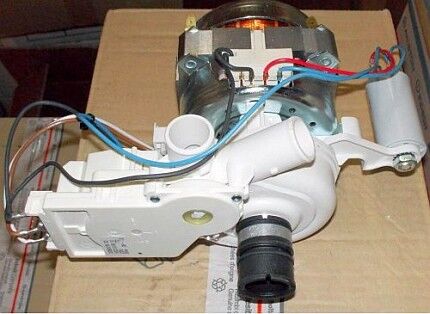
Behind the dishwasher door is an internal space with a mechanism that is directly responsible for cleaning dishes.
It is not the same in all devices: expensive PMMs provide spraying from all sides, while the cheapest ones provide spraying only from below.
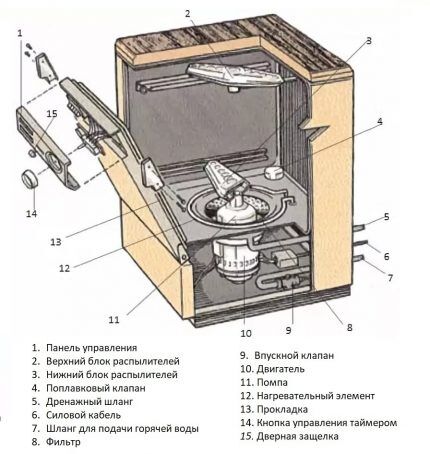
The main parts located inside the working space of the dishwasher are:
- PMM housing. Made of stainless steel. Its walls do not experience strong mechanical stress, so the thickness of the metal at the tank is minimal.
- Rocker arms for spraying liquid under pressure. They do not have a special drive, but rotate due to the oblique arrangement of several outlet holes.
- Baskets for storing dishes. Several of them can be placed in the internal space. The size of the baskets usually differs: at the bottom there is a more spacious one for pots, and at the top there is a compact one for plates, mugs, and cutlery.
- Filter system. Located in the lower sector of the tank, it consists of an upper mesh and a lattice glass located under it.
- Compartment for loading funds. Designed for detergent, rinse aid and water softener. These three containers can be located separately or connected within one dispenser.
- Sealing rubber bands and a light bulb.
Without the listed components, the dishwasher simply will not be able to perform its functions efficiently. But other elements can be installed inside the PMM, providing expanded capabilities and making it easier to work with the device.
Types of modern models
Not all apartments have spacious kitchens that can accommodate full-size dishwashers. Therefore, manufacturers have invented many alternative devices that can wash dishes and not take up much space. All of them are exclusively electric with forced water pressure.
Four structural types of PMM can be distinguished:
- Built-in under the countertop.
- Standing separately.
- Compact and portable.
- Top loading.
PMMs built under the countertop usually have a depth of 57 cm, which allows for the necessary communications between the device and the wall. But different models can differ significantly in their characteristics from each other, which is worth considering when choosing a suitable dishwasher. We reviewed the main selection criteria and rating of the best built-in models in this publication.
If installed correctly, the front edge of the built-in machine with a depth of 57 cm will be flush with the table. Read more about installing a built-in dishwasher wrote here.
The width of the dishwasher can be compact (44-46 cm) or full size (56-60cm). Their height is usually standard - 81-82 cm with the ability to adjust.
Freestanding PMMs are equipped with a beautiful and durable top panel on which you can put some things. The vibration of the machine during operation is minimal, so you don’t have to worry about objects slipping. More details about the characteristics of free-standing machines and features of choosing the best we talked about in the next article.
Such devices are installed either near the edge of the tabletop, or in the next room where there are the necessary communications. The dimensions of free-standing PMMs are similar to built-in ones.
Compact, portable dishwashers are convenient when living in rented apartments. They do not require installation work and can be installed both on the floor and on a table. The typical size of such a PMM is 44*55*50 cm, which follows take into account when choosing.
To connect them, just connect a flexible hose to the water tap and lower the drain pipe of the machine into the sink.
PMMs with vertical loading are rarely produced. They usually have one level of storage of dishes, therefore they are functionally limited.
Regardless of the type of dishwasher, their operating principle is similar. However, the technical features of the models still affect the quality of cleaning dishes and the energy efficiency of the devices as a whole.
Additional functionality of PMM
The basic configurations of dishwashers were discussed above. Inexpensive models from different manufacturers have approximately the same cost and functionality, so they differ little from each other.
But there are also premium class dishwashers that provide consumers with additional options.
Such devices may include the following non-standard components:
- Devices for drying dishes: additional heating elements, fans, heat exchangers, ventilation ducts.
- Automation to protect the control panel and door from children.
- Guide bars for convenient installation of baskets in the working chamber.
- Seamless control panels that look stylish and are easy to clean.
- Indicators of the remaining time until the end of the wash and the duration of each washing stage.
- Built-in water softener. It lasts quite a long time and is subject to regular regeneration.
- Additional tubes for connecting hot water directly from the water supply.
- A sensor system that detects the need to add softening salt to the water. Sometimes it works fully automatically in conjunction with a dosing device.
- 3-in-1 detergent unit, allowing you to install one cartridge with detergent, rinse aid and softening salt.
- Built-in heat exchangers that reduce temperature differences and increase the energy efficiency of PMM.
- Water purity sensor. It helps determine when rinsing is complete, saving time and energy.
- "Beam on the floor" system. It is a light indication projected onto the floor, allowing you to evaluate the current operating mode of the device.
- System for adjusting the height of baskets with dishes.
- A drying sensor that allows you to determine its optimal mode based on the characteristics of the external air.
Professional machines include most of the listed devices, which ensures high quality dish cleaning, energy efficiency and ease of use.
But you should understand that every additional part in the dishwasher increases its cost.
Dishwasher operating diagram
Modern PMM is a complex device. To understand the functional significance of its components, you should consider step by step the principle of operation of the device.
So, while washing dishes in a dishwasher, the following processes occur.
- The dishes are loaded, the required washing mode is selected and the machine starts.
- The inlet valve opens, water begins to fill, and the heater turns on.
- When the pressure switch is activated, the inlet valve closes.
- Detergent is added to the water, salt, although the latter may be permanently in the flow compartment.
- The circular pump turns on, and water begins to flow under pressure from the holes of the nozzles, spinning them.
- After draining and filtering, the water again enters the pump through a container with salt.
- After the washing cycle is completed, dirty water is pumped into the sewer, and clean and cold water is collected instead. The first rinse cycle begins.
- After the first rinse is completed, the liquid is drained by the pump and new water is drawn in. It is heated and then added to it rinse aid. The second rinse cycle begins.
- After the second rinse is completed, the water is drained into the drain and the drying process begins.
Drying the dishes ends the dishwasher's operating cycle.
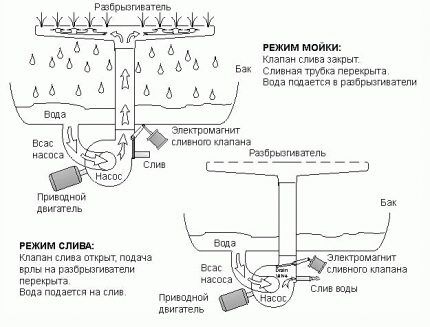
To ensure high-quality washing, it is advisable to wipe the dishes from large pieces of food before placing them in the PMM. Then all the dirt will be washed away after the washing stage and will not get on the products during the rinsing period.
Types of drying in a dishwasher
Sometimes the PMM has to be loaded several times in a row. Such situations require accelerating wash cycles. They can be reduced by stimulating the drying of dishes.
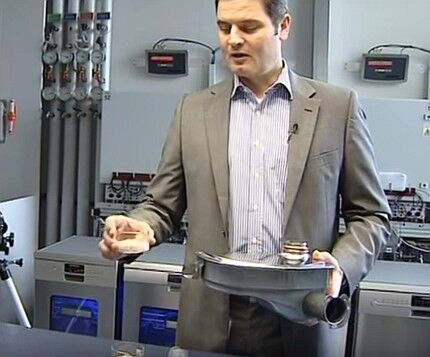
In total, 3 types of drying are used in dishwashers:
- Condensation. It is the usual drying of warm drops on dishes and their settling on the cold side walls. This process is passive and lengthy.
- Turbo drying. Fans supply warm air to the machine, passing through the heating elements. This drying method is the fastest, but requires increased energy consumption.
- Intensive drying, in which the passive flow of fresh air into the inner chamber is stimulated due to convection currents. For this purpose, the PMM is equipped with air intakes.
Some dishwasher models provide the ability to choose between several types of drying. They all have their own characteristics, and you can turn them on based on the need to quickly release the PMM.
Maintainability of PMM parts
Almost all dishwasher parts are replaceable. But some of the repair work can be performed by the user himself, and some can only be carried out by service center specialists.
Parts are expensive, so before repairing a breakdown, you should think about whether it would be easier to buy a new device. Next, we will consider the features of replacing some components of the PMM.
No. 1 - electric circulation pump
Basic wash cycle dishes is ensured by the operation of a circulation pump, which maintains the required water pressure at the outlet of the sprinklers. The cost of its replacement is 30-40% of the price of a new PMM.
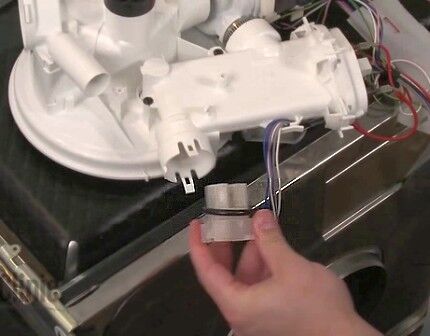
Replacing the pump is easy, but expensive. It is easier to ensure the normal functioning of the device and prevent breakdowns.This can be achieved by regularly cleaning the filters from dirt, preventing it from entering the water hoses. The warehouses of service centers almost always have the required pump model, so problems with the speed of replacing it should not arise.
A video describing the process of disassembling the unit to replace a failed pump will help you understand the structure and location of the dishwasher circulation pump:
No. 2 - drain system pump
The drain pump is responsible for pumping water out of the dishwasher. It has little power, but is an important component, without which the operation of the PMM is impossible.
The pump can break down for the following reasons:
- voltage fluctuations;
- clogging;
- increased load due to excessively long drain hoses.
Signs of an impending breakdown are a humming sound when draining water and slow pumping. The pump is quite universal, so replacing it will not be difficult. The cost of a new device is about 1000 rubles, and it is usually available at every service center.
No. 3 - control device board
Electronic microcircuits are vulnerable to most physical factors. Damage to control boards on PMMs is usually caused by either a manufacturing defect or voltage surges in the electrical network. The cost of replacing it ranges from 15-30% of the price of a new dishwasher.
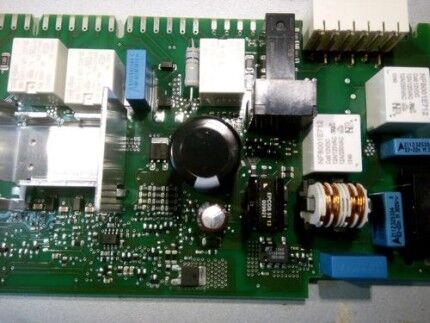
For places with problematic voltage, we can advise you to buy it stabilizer, but the cost of such a device will be at least 10,000 rubles.
System boards are specific, so you will have to wait quite a long time for a package with the product from the support service center, and it is unlikely that you will be able to replace it yourself. Therefore, the failure of this part will be a big problem, the solution of which will require time and money.
No. 4 - water inlet valve
The inlet valve can break in two cases: burnout of the electromagnetic coil and failure of the seal. This problem is rare, but to solve it you will have to spend 1500-2500 rubles.
A sign of coil burnout will be the absence of water flow when starting the PMM, because when the valve is turned off, the valve is closed. If the seal is broken, a leak will occur, but to accurately determine its source, you will first need to disassemble the machine.
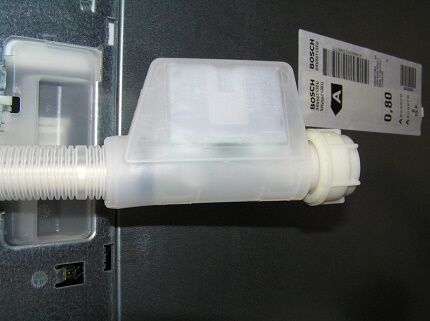
No. 5 - flow heaters and heating elements
PMM users may not notice the inoperability of the heaters for months if the automation does not signal this. Symptoms of failure of these devices may be a deterioration in the quality of washing dishes and an increase in the drying time.

The cost of a new heating element for a dishwasher ranges from 1000 to 3000 rubles. You can replace it yourself if you know how to get to it.
You can install a heater from another model in a dishwasher if it is structurally suitable and does not have specific connectors. Therefore, a breakdown of the heating element can be repaired quickly and inexpensively, and our step-by-step instructions to replace the heating element will help you with this.
No. 6 - elements of drying equipment
Repairing drying equipment can be a big problem. On websites you rarely find spirals or fans for specific PMM models. Therefore, ordering these parts will have to be done only through official service centers.
Those consumers whose dishwashers can operate with a broken dryer will be lucky. And if the automation gives an error, you will have to wait weeks for the device to be repaired.
But you shouldn’t worry too much about problems with drying, because this equipment is reliable and rarely fails. You can replace the heating coil or fan yourself, but it is better to use the services of a service center.
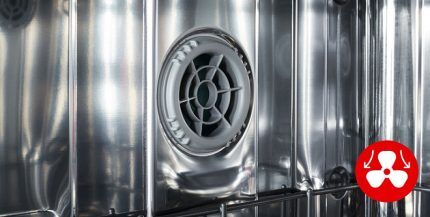
No. 7 - other PMM components
Almost all parts of the dishwasher can fail. Rough handling of cookware can lead to breakage of spray nozzles or damage to sealing gaskets. And voltage surges can cause burnout of sensors, actuators, starters and other electrical devices.
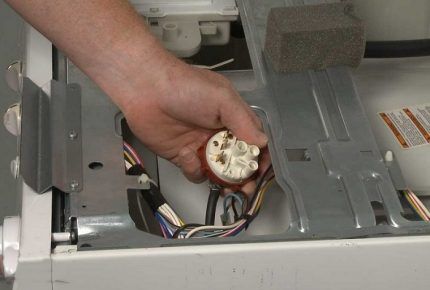
You may also need to replace filters, dispensers, hoses, fasteners and other small parts. It should be remembered that the less often a part breaks and the smaller it is, the higher the margin manufacturers will include in its price. For example, a breakdown of a simple plastic salt dispenser will cost 5,000-6,000 rubles.
The high cost of repairing PMM should encourage consumers to treat it with care. Then both money and nerves will be saved.
Conclusions and useful video on the topic
The presented video materials will allow you to better understand the structure of the dishwasher, see the operation of the machines from the inside and become familiar with the process of disassembling them.
Dishwasher structure:
A dishwasher in the home is gradually becoming the norm, not the exception. But almost any breakdown of this equipment will be a strong blow to your wallet.
Therefore, despite its reliability, PMM requires careful handling and compliance operating rules.
Do you still have questions about the dishwasher? Ask them in the comments block - our experts and other site visitors will try to help you.
If you want to supplement our material with useful information or recommendations, please write them below under this article.




I read that you can put something on the lid of free-standing dishwashers (this, as I understand it, distinguishes them from washing machines, on which it is not recommended to put anything on them at all). Are there any restrictions on the weight and type of what can be placed on the dishwasher lid? For example, a small microwave oven - is it possible? What about an electric kettle? There is not much space in the kitchen, and I would like to use all the surfaces.
There are no restrictions on weight, within reason, of course. The problem with installing a microwave on a dishwasher is that running both devices at the same time can damage the dishwasher's control module. In general, microwave radiation is harmful not only to people, but also to any electrical appliances.
Within reasonable weight and dimensions, you can put whatever you want in the dishwasher. Of course, if you plan to install a microwave oven and an electric kettle, then you need to take care of the wiring, which must withstand the load from such powerful devices.
It is better to connect the dishwasher separately through an individual stabilizer, since this household appliance does not like voltage fluctuations. At my house the dishwasher is built into the furniture, so I forgot about this distribution of space. Previously, there was a microwave oven on the dishwasher and there were no problems.
Regarding the washing machine, I can say that if it is leveled, then it is suitable for using the space on its lid.
I get error 11. What does this mean, please tell me?
Good afternoon Unfortunately, you did not indicate the brand of dishwasher, but we will try to help you. We list all the brands of cars in which error 11 may be displayed:
1. AEG - malfunction of the transparency sensor;
2. Bosch - no water heating;
3. Electrolux - problems with the transparency sensor;
4. Miele - problems with draining waste water;
5. Neff - no water heating;
6. Siemens - heating element does not work;
7. Whirlpool - electronic water sensor failure;
8. Zanussi - transparency sensor malfunction.
Is your dishwasher not on the list? Please write your make and model and we will try to help you.
Dishwasher Electrolux. After turning on the mode, it works until the first flush and freezes. The drain pump works and that's it. It does not give an error, time stops.After a power outage, it may start working again after (at least) six hours, but not for long. What could be the reason? Thank you.
What voltage and how many volts is supplied to the water supply valve? Thank you.
Good afternoon. Please tell us we have PMM Zanussi, I used to clean the water and dirt sensors myself and the machine continued to work until the next error and now error f0 is the first time like this and I can’t do anything, after cleaning the water hardness and dirt sensor the machine will wash the dishes a couple of times and then quit error f0 and water remains at the bottom of the machine, tell me what to check
GORENJE GV62211. We found a rubber ring-cuff at the bottom. When I climbed inside, I found two fittings opposite the middle sprinkler, the lower one with a check valve. The top one had no cuff. I removed the cuff from the bottom one, and it turned out that it was noticeably smaller in diameter than the one we found. That is, the small one sat more or less tightly in the groove, but the big one dangled, which is why, apparently, it flew off. What is this, a crap assembly? Is it really necessary to call a repairman (okay, there’s still a guarantee)? For some reason the photos are not loading.
I'll try to upload the second one now
Looks like I figured it out. The lower fitting works when the upper basket, together with the sprinkler, is lowered to the lower position (there is such an option there. So far I have moved the cuff from the lower to the upper one. But it’s still strange: is the old one stretched? So why call a repairman? What crap? -That…
What is the name of the small plug with a through hole that connects the tank, which is located on the side under the casing, and the main washing compartment.
Can you tell me the brand/brand of dishwashers with the most reliable circulation pumps?
Hello. Tell me whether all dishwashers have a built-in drain check valve or not. If so, why do many websites write about the need to install water seals by bending the drain hose or installing a check valve at the entrance to the sewer pipe?
Good afternoon . When turning on the dishwasher model DW-08T1ME(W)-ISR. TOSHIBA, the sound of the electric motor starting is heard. Then the indicator indicating fault E 1 begins to blink and the machine stops working and the indicator is constantly on. Please tell me what kind of malfunction this is and how to fix it. The machine is new, just connected and never used. Thank you
Good afternoon.
They discourage you from buying a dishwasher with zeolite drying, citing the fact that if foam from excessively added detergent gets on the zeolite during drying, the system fails. Is it so? Thank you
Good afternoon. I have a “divider location” error on my dishwasher. What is a “divider” and where is it located? Is this an operational error or a manufacturing defect?
Hello. PMM Veko DIS 5831, water is being released from the heat exchanger, from the air hole. Demonstration video here https://www.youtube.com/shorts/ihBEv3tMeyo